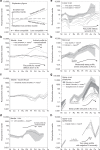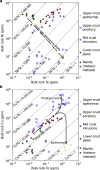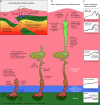A metasomatized lithospheric mantle control on the metallogenic signature of post-subduction magmatism
- PMID: 31383863
- PMCID: PMC6683204
- DOI: 10.1038/s41467-019-11065-4
A metasomatized lithospheric mantle control on the metallogenic signature of post-subduction magmatism
Abstract
Ore deposits are loci on Earth where energy and mass flux are greatly enhanced and focussed, acting as magnifying lenses into metal transport, fractionation and concentration mechanisms through the lithosphere. Here we show that the metallogenic architecture of the lithosphere is illuminated by the geochemical signatures of metasomatised mantle rocks and post-subduction magmatic-hydrothermal mineral systems. Our data reveal that anomalously gold and tellurium rich magmatic sulfides in mantle-derived magmas emplaced in the lower crust share a common metallogenic signature with upper crustal porphyry-epithermal ore systems. We propose that a trans-lithospheric continuum exists whereby post-subduction magmas transporting metal-rich sulfide cargoes play a fundamental role in fluxing metals into the crust from metasomatised lithospheric mantle. Therefore, ore deposits are not merely associated with isolated zones where serendipitous happenstance has produced mineralisation. Rather, they are depositional points along the mantle-to-upper crust pathway of magmas and hydrothermal fluids, synthesising the concentrated metallogenic budget available.
Conflict of interest statement
The authors declare no competing interests.
Figures



References
-
- Richards JP. Postsubduction porphyry Cu-Au and epithermal Au deposits: products of remelting of subduction-modified lithosphere. Geology. 2009;37:247–250. doi: 10.1130/G25451A.1. - DOI
-
- Richards JP. Magmatic to hydrothermal metal fluxes in convergent and collided margins. Ore Geol. Rev. 2011;40:1–26. doi: 10.1016/j.oregeorev.2011.05.006. - DOI
-
- Fiorentini ML, et al. Post-collisional alkaline magmatism as gateway for metal and sulfur enrichment of the continental lower crust. Geochim. et. Cosmochim. Acta. 2018;223:175–197. doi: 10.1016/j.gca.2017.11.009. - DOI
-
- Tomkins AG, et al. Magmatic sulfide formation by reduction of oxidized Arc basalt. J. Petrol. 2012;53:1537–1357. doi: 10.1093/petrology/egs025. - DOI
Grants and funding
- NE/M010848/1/RCUK | Natural Environment Research Council (NERC)
- NE/M011615/1/RCUK | Natural Environment Research Council (NERC)
- NE/P017053/1/RCUK | Natural Environment Research Council (NERC)
- NE/P017312/1/RCUK | Natural Environment Research Council (NERC)
- CE11E0070/Department of Education and Training | Australian Research Council (ARC)
LinkOut - more resources
Full Text Sources

